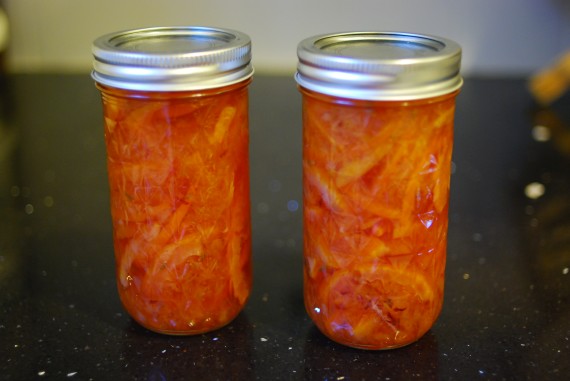
Let me just start by saying that I am no pro canner. Yes, I dabble, I have the special canning tongs and lid-lifter-magnet, and I have performed the canning process a handful of times, but it was never anything too complicated. But after a satisfying tomato canning experience (fresh, local, organic produce turned into a pantry staple by my very own hands!), I knew I wanted to expand my canning credentials and venture into more advanced canning endeavors, but where to start? Enter The Can Jam.
I’ve been using Twitter a lot lately (follow me @PantryTweets), and through it I have met and exchanged ideas with some amazing cooks all over the world who are doing some really exciting things. One of these cooks has two wonderful blogs that I read, and wouldn’t ya know it, she is a fellow Queens resident, and she LOVES to can (and pickle!).
Tigress is holding a year-long online canning project which I am enthusiastically embracing with all of my canning heart. Each month, she’ll post an ingredient on her site, and then invites others to can/preserve/pickle a recipe highlighting that ingredient and share their results. January’s ingredient is citrus, and I immediately thought of attempting a true champion of preserves: Marmalade.
Before you read any further know this: canning marmalade is sticky business!
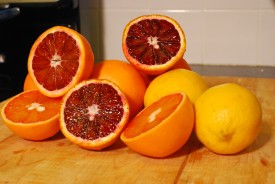
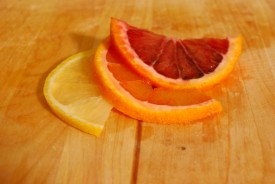
The first thing to do was to figure out what type of marmalade I was going to make. Since citrus isn’t found in the Northeast I can’t just rely on my CSA to provide it, so I had to see what organic citrus looked good at my grocer (not just any grocer, Fairway Market), since with marmalade you end up eating the rind, where pesticide residues can collect, organic is the way to go. I was excited to find not just organic lemons and oranges, but organic blood oranges–what a treat! When I got home I consulted my trusty cookbook collection and found a nice recipe in Joy of Cooking for Bitter Orange Marmalade, which I modified to include blood oranges, ginger, and fennel seed. The following is an account of the steps (and occasional missteps) I took. I hope this gives those of you who’d like to try canning that extra push you need to just GO FOR IT!
IMPORTANT: If the preserve is not prepared properly, it can be dangerous. If you are new to canning (myself included) follow the recipe exactly, especially amounts of sugar, fruit, and processing times (spices can be played around with without compromising safety). For canning steps, and a great resource, check out the National Center for Home Food Preservation, or these great bloggers and fellow Can Jam participants: Tigress in a Jam, Married…With Dinner, Food In Jars, Dorris and Jilly Cook, and Garden Fresh Living (for a full list of participants, check out Tigress’ master list.)
Tricalore Spiced Citrus Marmalade
Makes about 10 1/2 pint jars (I made five 4 oz jars, and five 12 oz jars. (I processed the 12 oz jars for 15 min, vs. 10 min for the 4 oz)
- 1 lb oranges
- 1 lb blood oranges
- 8 oz unpeeled lemons
Chill, wash, halve crosswise, snip out tough centers, and thinly slice, removing any seeds.
Combine in a bowl, with their juice, and add:
- 8 cups of water
- 2 T chopped or grated fresh ginger (Feel free to add more, I will the next time I make this)
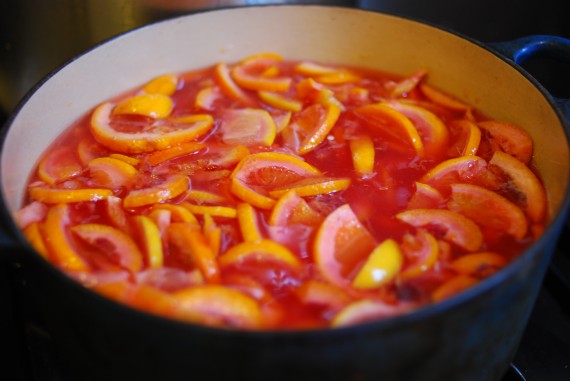
Cover and let stand overnight in the refrigerator. The following morning, simmer with the water until the citrus peel is tender. Then add:
- 6.5 cups sugar
- 1 T fennel seeds (again, what was I thinking? I would definitely add more of this next time too.)
Divide the mixture in half and cook in 2 batches. Bring each batch up to a rapid boil, stirring frequently, until you reach the jelling point*. Remove from the heat and skim off any foam. Combine the batches, then pack into hot 1/2 pint jars, leaving 1/4 inch headspace. Process for 10 minutes.
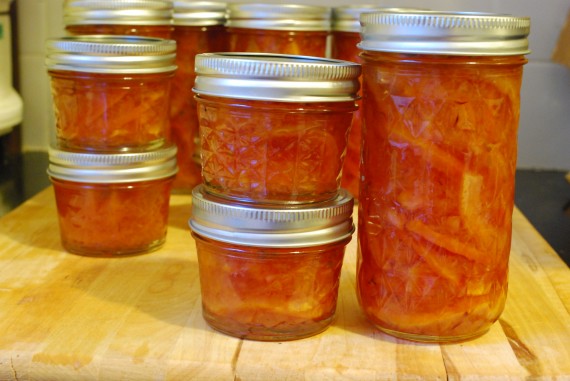
* The jelling point is a temperature/moment when the pectin reaches it’s zenith, and the preserve sets. But…MY MARMALADE DIDN’T SET! There are various tests to see if the jelling point has been reached; I did the “quick chill test”, in which you drop a small amount of the syrup onto a chilled saucer, let it sit for a few minutes, and then run a finger through it. The marmalade is set when the line of your finger stays, and the sides don’t move or when the marmalade crinkles when running your finger through it. Mine never got to that stage, but it did hold a line, which various sources explained as a “soft” set. I was afraid to keep boiling away (my sources said that if boiled too long, the preserves will overcook and be runny), and convinced myself, at the time, that a soft set was fine. In retrospect, I should have boiled a little longer. I’m told this jelling point thing will get easier with practice and experience, which I’m excited to get tons of this year!
Despite the syrupy consistency, I am thrilled with the color and flavor of my first foray into marmalade. It’s a little bitter (which I don’t really mind), and I think it will be delicious with sweet buttered bread.

beautiful photos a delight to my eye (only one of them
Thanks for the shout-out! I’m curious: did your marmalade get any firmer as the days have gone by? My strawberry lemon concoction was just on the borderline of being too firm, and it looks like it’s getting stiffer as time goes on. Tip over a jar and have a look….
i always had a hard time finding the gel point with the plate or spoon test. I’ve invested in a candy thermometer and it makes things SO MUCH EASIER. Your jam or jelly will set when it reaches 220 degrees. now i know it will never fail. also, you can save your seeds, put them in a tea ball or a piece of cheesecloth and boil it with your fruit. the seeds and peels are where most of the pectin is. Also, sometimes it takes a few weeks for your jelly to fully set. it could be a bit liquidy now but might firm up in a bit. anyway your marmalade looks fantastic! happy canning and add me on twitter if you like. @sweetandsourjam
Cool! Check out my can jam project for this month:
http://motherskitchen.blogspot.com/2010/01/crimson-honey-grapefruit.html
Wow, this looks and sounds SO good. And those blood oranges – they are so beautiful!
Great job! God, I love blood oranges. Fennel and ginger, sounds good! And, what they said, sometimes it takes even up to a week to set.
Doris: You’re welcome! The marmalade didn’t really get firmer since I processed. I was hoping that would be the case, but alas, I’ll have to just be more mindful of the jelling point next time.
Liz: Thanks so much for the comment and all those suggestions. As I’m just getting into preserving, they are very helpful. I think I will take your advice and get a candy thermometer!
I always use a thermometer. However, I have found that some recipies simply have too much water. You can figure that out by comparing your recipie to similar ones. The few times my marmalade or jam failed to gel sufficiently, I found that it made excellent syrup. Also, it mixes into things more easily. Surprisingly, blood orange marmalade is really good with plain yogurt.
Thanks for the tips, Eleanor. I’ll definitely be getting a thermometer before next month’s canning challenge!
What an amazing color! Great flavor combos! I used ginger in mine too
I am new to your blog, and am excited to explore your past postings, but this one caught my eye. I made marmalade for the first time last week! I have never been much of a canner, but I was inspired by a bag of key limes. So it is a key-lime and lemon marmalade. I thought mine was bitter at first, but spread on buttered toast, it is delicious!
What a beautiful looking marmalade! To follow up on Liz’s tip about the citrus pits, here’s a trick I’ve used that worked really well: collect all the pips and place in a little water in the fridge. Cover. Leave overnight. This seems to draw out even more pectin. Toss in the small quantity of water when making your jam. You can also put the seeds in muslin and boil it all up, just in case there’s extra pectin left. Also, in my experience you cannot over-boil marmalade. If you boil it past the set point, it usually sets up even firmer.
If you find your marmalade too runny, simply open up all your cans, pour the runny jam into your pot, and boil some more. You could add the juice of a lemon (or even a sachet of pectin, but I hate using it if I don’t have to). Your jam should set when it’s hot enough and when you’ve evaporated off enough moisture. Then you can re-can as before. If you’re refrigerating it or eating it soon, you could even re-use the lids.
Diane, thanks so much for your comment. The next time I make marmalade I will definitely use some of these tips!
ive been making marmelade for a few years and still haven’t mastered the gelling. lately i read that cooking to long may make it fail which i didn’t know. ive always just cooked it again which more or less works. i’ve also notice that sometimes when not gelled it gels a few days later. i wonder though where the line is: how many days one must wait until failure is prooved.
what is the ideal cooking time? in a big pot, it takes quite a while for it to start boiling, but once it boils, how long should it cook?